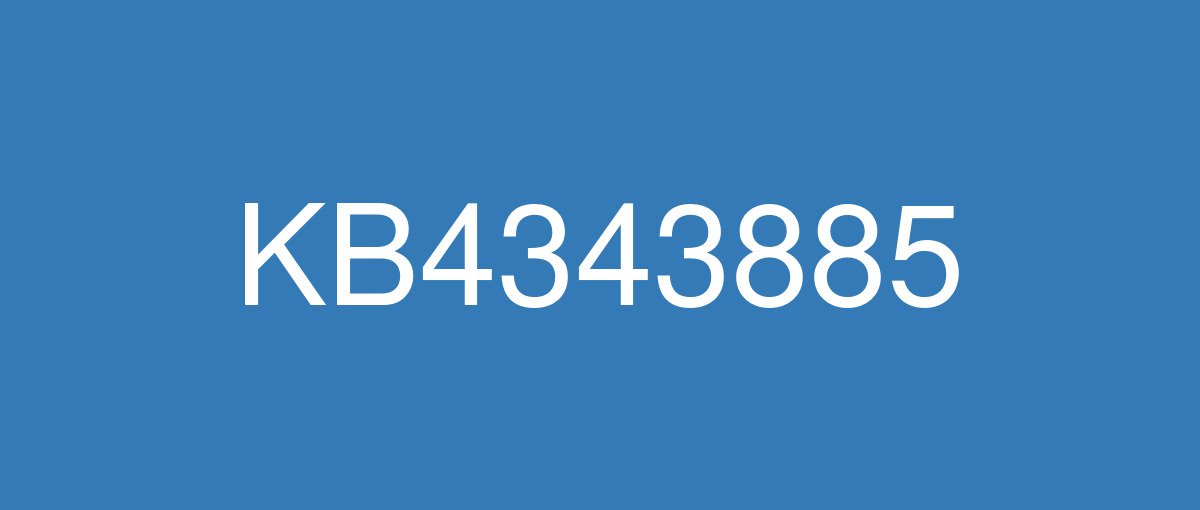KB4343885

詳細情報
| KB番号 | KB4343885 |
|---|---|
| リリース日 | 2018/08/14 |
| Windowsバージョン | Windows 10 1703 |
| ビルド番号 | 15063.1266 |
| URL(英語) | https://support.microsoft.com/en-us/help/4343885 |
| URL(日本語) | https://support.microsoft.com/ja-jp/help/4343885 |
| ダウンロード | Microsoft Update Catalog |
ハイライト(英語)
改良点(英語)
Provides protections against a new speculative execution side-channel vulnerability known as L1 Terminal Fault (L1TF) that affects Intel® Core® processors and Intel® Xeon® processors (CVE-2018-3620 and CVE-2018-3646). Make sure previous OS protections against Spectre Variant 2 and Meltdown vulnerabilities are enabled using the registry settings outlined in the Windows Client guidance KB article. (These registry settings are enabled by default for Windows Client OS editions.)
Addresses an issue that causes Internet Explorer to stop working for certain websites.
Updates support for the draft version of the Token Binding protocol v0.16.
Addresses an issue that causes Device Guard to block some ieframe.dll class IDs after installing the May 2018 Cumulative Update.
Ensures that Internet Explorer and Microsoft Edge support the preload="none" tag.
Addresses a vulnerability related to the Export-Modulemember() function when used with a wildcard (*) and a dot-sourcing script. After installing this update, existing modules on devices that have Device Guard enabled will intentionally fail. The exception error is “This module uses the dot-source operator while exporting functions using wildcard characters, and this is disallowed when the system is under application verification enforcement”. For more information, see https://portal.msrc.microsoft.com/en-US/security-guidance/advisory/CVE-2018-8200 and https://aka.ms/PSModuleFunctionExport.
Addresses an issue that was introduced in the July 2018 .NET Framework update. Applications that rely on COM components were failing to load or run correctly because of “access denied,” “class not registered,” or “internal failure occurred for unknown reasons” errors.
Addresses a vulnerability issue by correcting the way that the .NET Framework handles high-load or high-density network connections. For more information, see CVE-2018-8360.
Security updates to Windows Server.
既知の不具合(英語)
ありません
ハイライト(日本語)
ありません
改良点(日本語)
Intel® Core® プロセッサおよび Intel® Xeon® プロセッサに影響する L1 Terminal Fault (L1TF) という新しい投機的実行サイドチャネルの脆弱性に対する保護機能を提供します (CVE-2018-3620 および CVE-2018-3646)。 Windows クライアント向けガイダンスのサポート技術情報に記載されているレジストリ設定を使用してスペクター バリアント 2 およびメルトダウンの脆弱性に対する以前の OS の保護機能が有効になっていることを確認します (Windows クライアント OS エディションでは、これらのレジストリ設定は既定で有効です)。
一部の Web サイトで Internet Explorer が動作しなくなる問題を修正します。
Token Binding プロトコル v0.16 のドラフト版のサポートを更新します。
2018 年 5 月の累積的な更新プログラムをインストールした後に、Device Guard で一部の ieframe.dll クラス ID がブロックされる問題を修正します。
Internet Explorer と Microsoft Edge で preload="none" タグがサポートされるようになります。
ワイルドカード (*) およびドットソーシング スクリプトを使用した場合の Export-Modulemember() 関数に関連する脆弱性を解決します。 この更新プログラムをインストールすると、Device Guard が有効なデバイスの既存のモジュールは意図的に失敗します。 “This module uses the dot-source operator while exporting functions using wildcard characters, and this is disallowed when the system is under application verification enforcement” (このモジュールは、ワイルドカード文字を使用して関数をエクスポートするときにドットソース演算子を使用しましたが、システムでアプリケーション検証が実行中の場合は使用できません) という例外エラーが発生します。 詳細については、https://portal.msrc.microsoft.com/ja-jp/security-guidance/advisory/CVE-2018-8200 と https://aka.ms/PSModuleFunctionExport (英語情報) を参照してください。
2018 年 7 月の .NET Framework の更新プログラムで導入された問題を修正します。 “アクセスが拒否された”、“クラスが登録されていない”、または “不明な理由で内部エラーが発生した” ため、COM コンポーネントに依存するアプリケーションの読み込みまたは実行に失敗しました。
Windows Server のセキュリティ更新プログラム。
既知の不具合(日本語)
ありません